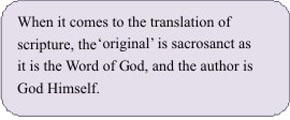| |
Introduction
The topics we have discussed so far have centred around translation of secular texts. But there has been  largescale translation of religious texts across the world. Translation of religious texts is a rather uneven terrain in the history of translation, mainly because the orthodox belief is that the word of God cannot be translated by human hand. The authenticity of the original becomes sacrosanct here, and the assumption that translation is secondary, slavish or derivative is made concrete. This reverence for the original word of God can be seen in religious faiths across the world and cultures, including tribal culture, where God speaks only through the shaman, or the person chosen specifically to become the voice of God. Any other ‘translation’ would be false and listening to or reading it would be blasphemy. largescale translation of religious texts across the world. Translation of religious texts is a rather uneven terrain in the history of translation, mainly because the orthodox belief is that the word of God cannot be translated by human hand. The authenticity of the original becomes sacrosanct here, and the assumption that translation is secondary, slavish or derivative is made concrete. This reverence for the original word of God can be seen in religious faiths across the world and cultures, including tribal culture, where God speaks only through the shaman, or the person chosen specifically to become the voice of God. Any other ‘translation’ would be false and listening to or reading it would be blasphemy.
However, this does not mean that the scriptures have not been translated at all. In fact, individual translations and interpretations have helped the growth of religions, especially Christianity. Of all the religious texts to have been translated, the Bible towers above others in terms of sheer magnitude and scope of its translation. The translation of the Bible, as is true of the sacred texts of other religions as well, gains added significance when you consider the impact it had on the evolution and standardization of different languages round the world. So, other than the issues that are raised by the process of translation, scriptural translation needs to be analysed also for its influence on the growth and survival of languages.
|